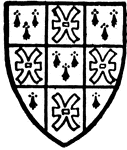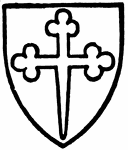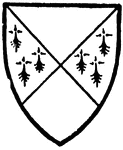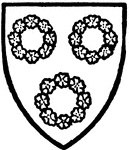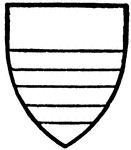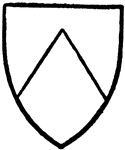
Andrew Harcla
Andrew Harcla, the march-warden, whom Edward II made an earl and executed as a traitor, bore the arms…

Cross urdee
A cross-urdee is one in which the extremities are drawn to a sharp paint instead of being cut straight.

Vair
Vair is one of the furs in heraldry composed of several silver and blue pieces representing little shields.

Voided Cross
Voided, in heraldry, a term applied to a charge or ordinary pierced through, or having the inner part…

Chetwode
Chetwode bore Quaterly silver and gules with four crosses forming countercoloured- that is to say, two…

Skirlaw
Bishop of Durham, the son of basket weaver, bore Silver a cross of three upright wattles sable, crossed…

Drury
Drury bore Silver a cheif vert with a Saint Anthony's cross gold between two golden molets, pierced…

Melton
Melton bore Silver a Tolouse cross gules. By giving this cross a name form the counts of Toulouse, it's…

Upton
Nicholas Upton, the 15th-century writer on armory, bore Silver a saltire sable with the ends couped…

Elwett
Mayster Elwett of Yorke chyre in a 15th-century roll bears Silver a saltire of chains sable with a crescent…

Gascoigne
Gascoigne bore Silver a pale sable with a golden conger's head thereon, cut off at the shoulder.

Lancaster
Henry of Lancaster, second son of Edmund Crouchback, bore the arms of his cousin, the King of England,…

Fraunceys
Adam Fraunceys (14th century) bore Party gold and sable bendwise with a lion countercoloured. The parting…

Ever
Ever or Eure bore quarterly gold and gules with the addition of a bend sable with three silver scallops…

Whitegrave
Whitegrave of Staffordshire Nine pieces of Azure and of Stafford's arms which are gold with cheveron…

Tallow Chandler
The Tallow Chandlers of London had a grant in 1456 of Six pieces azure and silver with three doves in…


